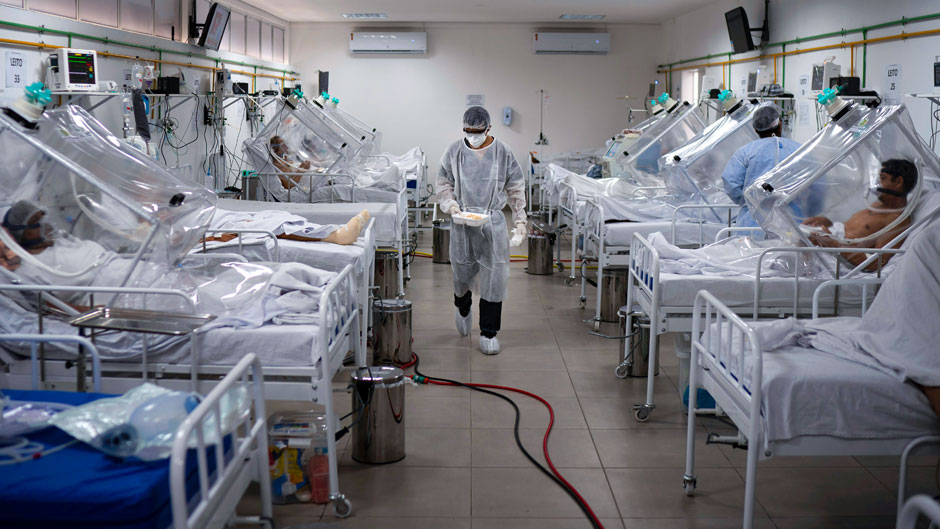Brazil, which has followed the inept example of Mexico in failing to swiftly enact national public health policies to contain the coronavirus pandemic, has now become the world leader in terms of infections and daily deaths, according to the latest round of data provided by the Latin America COVID-19 Observatory.
In a trilingual webinar Tuesday, members of the University of Miami-led initiative that provides timely data in an effort to improve government public health policy responses and save lives, along with a leading Brazilian epidemiologist, analyzed the observatory’s study on Brazil.
“This is a very timely discussion as Latin America has now become the world’s hot spot for COVID-19 infections and deaths, accounting for 40 percent of the daily registered deaths globally, and Brazil has reached a critical phase in its response to the COVID-19 pandemic,” said University of Miami President Julio Frenk, setting the context for the session.
Frenk, a former health minister in Mexico and global public health expert, highlighted the “enormous expressions of solidarity, service, and sacrifice in the region, particularly on the part of frontline health workers and researchers” in seeking to combat the contagion.
“In that spirit of solidarity, we are presenting this data,” he said, “yet, sadly, we are witnessing the peril of delayed action by populist governments that tend to devalue science and evidence—and that has put millions of lives at risk.”
The Latin America COVID-19 Observatory was developed by the Institute for Advanced Study of the Americas, Miller School of Medicine, College of Arts and Sciences, and the School of Communication, in collaboration with research partners throughout Latin America. A first round of data released several weeks ago focused on Mexico, and this second release centered on Brazil with a comparative regional data analysis.
The observatory provides daily updates on public health and physical distancing policies—10 variables in total—implemented at the national and subnational level, the only consortium to offer state-level regional data of this scope, explained Felicia Marie Knaul, director of the Institute for Advanced Study of the Americas and professor in the Department of Public Health Sciences at the Miller School.
Knaul noted that the observatory plans next to continue its assessment of other countries in the region and also to strengthen its collaboration with Brazil. She emphasized the value of providing state-level data that can be easily visualized on the website.
“From a research point of view, we will be able to look at differences across states and countries to help us explain what works and what doesn’t work in the face of a pandemic—and that should help with future preparedness and also what we might see in terms of second waves of the current pandemic,” said Knaul, who has been instrumental in advancing the initiative.
“Also,” she continued, “what we’ve seen in Mexico, in Brazil, and other countries with major variance is that if you demonstrate that some states are performing better than others, you can encourage those states that have weak public policy or even those that have enacted strong policy, but are still seeing mobility, that they need to adjust their public policies.” Such analysis, she said, can provide “an opportunity for an overall improvement at the national level by asking states to come together and do as well as the best-performing states.”
Knaul noted that Brazil, with now nearly 1,000 deaths a day and a trajectory that is on the upswing, is now the hot spot of the global pandemic.
“Our hearts and souls go out to all living in Brazil at the epicenter and to see how this is evolving, and we are here to do whatever we can to be supportive,” she said.
Alberto Cairo, Knight Chair in Visual Journalism and associate professor with the School of Communication, moderated the webinar. Cairo formed part of a robust collaborative effort from the school that played a major role in translating—linguistically, textually, and visually—the website’s data and display.
In pre-release findings on Brazil, the consortium observed that the administration of Brazil President Jair Bolsonaro wasted valuable time while COVID-19 spread across the country, a delay that obligated state and local governments to fend for themselves.
Michael Touchton, assistant professor of political science and the global health associate faculty lead for the institute with expertise in Brazil, highlighted the impact of the disparities in the differing responses of Brazilian states and other more recent trends in his presentation.
The best state performers were not limited to the wealthiest states, nor to those that are often considered the best governed, Touchton noted. Instead, political explanations—whether the state governor opposed or supported the Brazilian president—were a better indicator of how well the state was in controlling the contagion.
The relatively marginalized states of the northeast part of the country have responded more aggressively and have fared better, as have some northern states. And, governors from opposition parties lead these states and have imposed much stricter measures than what the Bolsonaro administration recommended, Touchton pointed out.
Cesar Victora, Brazilian epidemiologist and lead of the International Center for Equity in Health at Universidade Federal de Pelotas, provided a detailed analysis based on household surveys of 133 sentinel cities in Brazil’s 27 states.
In response to an audience question, Frenk said that the common element for both controlling the pandemic and opening the economy in Latin America and elsewhere is to do testing, both for surveillance and diagnostic in nature.
“It’s not a trade-off—the two objectives of controlling and opening have to go hand in hand,” Frenk said. “If you reopen the economy in an accelerated, reckless way, you will have a spike in cases. And, you may have to shut down the economy a second time.”
“And the third piece is clear, clear communication,” Frenk continued. “Communicating to the people so that they adhere to the physical distancing, protection of personal space by using masks, and extensive measures of personal hygiene—that is the combination that allows you to open the economy safely and to control the pandemic.”

